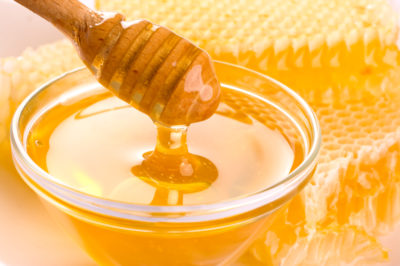You may already know that honey has a long history of use for healing. Perhaps you were given honey as a child when you had a cough or sore throat. Over the past couple of years, mainstream health practitioners have begun to appreciate the healing powers of honey.
The Internet, pharmacies and health food stores now offer “medicinal” or “pharmaceutical” grade honeys for sale, often at high prices. Do the medical and surgical grade honeys have advantages over grocery store or local honeys? How are they different?
Honey varies considerably in its ability to promote healing and fight infection. Much depends upon the source of the honey and the type of plants that the bees feed upon. If the bees obtain nectar from plants which contain active healing compounds themselves, the healing powers of the plants are transmitted via the honey. Some honey can even be poisonous if bees feed upon poisonous plants.
Let’s start by taking a look at basic honey from the hive. Raw, unheated honey is thick. The thick viscous texture offers healing benefits such as the ability to soothe inflamed tissues. The viscosity creates a healthy wound barrier and aids with the removal of infected tissues.
Honey is slightly acidic. The acid nature helps to fight infections. Raw honey creates antibacterial hydrogen peroxide which further assists with wound healing. It is not clearly understood how all of the antibacterial and antifungal compounds found within honey work.
Honey stimulates the immune system. Local honey contains pollen which may enhance resistance to airborne allergens when consumed on a regular basis. Taken regularly, honey may prevent hay fever and other upper respiratory complaints. Rarely, very sensitive individuals may suffer an allergic reaction, an asthma attack, or a potentially deadly anaphylactic reaction if they consume honey.
A Guide To Creating, Harvesting, And Cooking With Natural Honeys
Most natural health practitioners recommend the use of unprocessed local honey for general healing purposes.
Some of the most potent honeys are found in alpine regions, such as the Alps and the Andes mountains. Manuka and kanuka honeys from New Zealand are especially potent due to the types of plants the bees gather their nectar from.
Most commercial honeys, such as honey found in grocery stores, is filtered and heated. Some people believe that heating the honey ensures that the honey is safe as bacteria within the honey are destroyed. Unfortunately, heating honey destroys healing enzymes and reduces the honey’s potency. Heating honey can reduce the presence of botulism spores which may cause serious illness or even death, especially in infants. Most experts recommend that honey not be given to children under the age of one year.
Personally, I do not recommend the use of processed honey for healing purposes.
Medical, surgical or pharmaceutical grade honey is not honey at all. They are generally made from manuka honey. Kanuka and alpine honeys are sometimes used as well. They are rich in a component of honey called methylglyoxal. The compound possesses antibacterial, antifungal and anti-inflammatory properties. Methylglyoxal is extracted from the honey, combined with a sugar, and made into a potent powder. Manufacturers point out that their products contain higher concentrations of methylglyoxal than natural honeys. They state that combining the methylglyoxal with the sugar lengthens the time that the compound remains active. Smaller amounts of their products may be consumed in order to consume high levels of methylglyoxal. The chemical compound produced by manufacturers may be formed into shelf stable, pills, eye drops, nasal sprays, tablets and creams.
Pharmaceutical, medicinal, and medical grade honey is simply an extract of only one of the powerful compounds within honey. It does not contain the soothing texture of honey nor all of honeys other healing principles. The manufacturing process of producing medical honey is similar to the manner by which drugs are created by extracting active ingredients in plants and other resources. Experts are recognizing with greater regularity that simply extracting one compound may result in leaving other beneficial properties behind. Often the other healing properties are important for safe use. In addition, much is still unknown about other mechanisms involved in honey’s healing abilities. What is known is that highly processing honey destroys many of the healing qualities of honey.
I recommend the use of local unprocessed honey for everyday prevention and first aid. If I was treating a serious wound with honey and it did not heal as I expected, I would use a natural unprocessed manuka or manuka honey.
Honey effectively treats coughs, children’s insomnia due to coughs, surface burns, cuts, scrapes and other wounds. It is used to relieve cataracts and stomach ulcers caused by the H Pylori bacteria. Honey effectively treats many infections which are not responsive to antibiotic therapy, such as the now-rampant staph infection MRSA. Studies have been conducted which prove that honey is effective as a treatment for mouth sores caused by radiation. Animal studies suggest that it may prevent cancerous tumors from forming or metastasizing.
Honey is delicious as a preventative and as a healer. Store it at room temperature or cooler and in a dark place so that it retains its maximum potency.
 Off The Grid News Better Ideas For Off The Grid Living
Off The Grid News Better Ideas For Off The Grid Living





